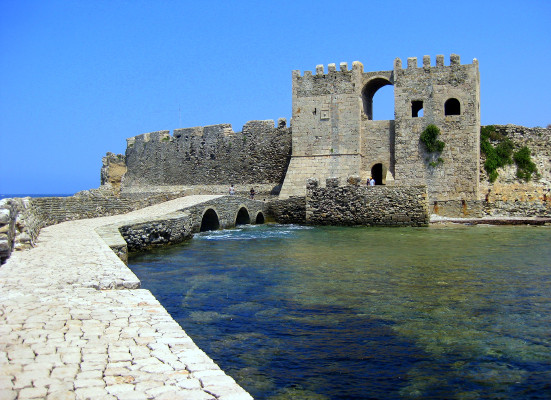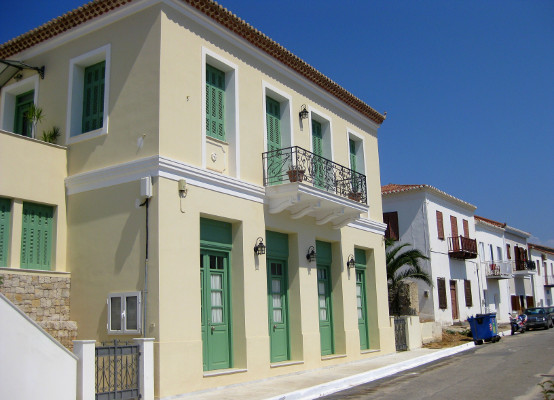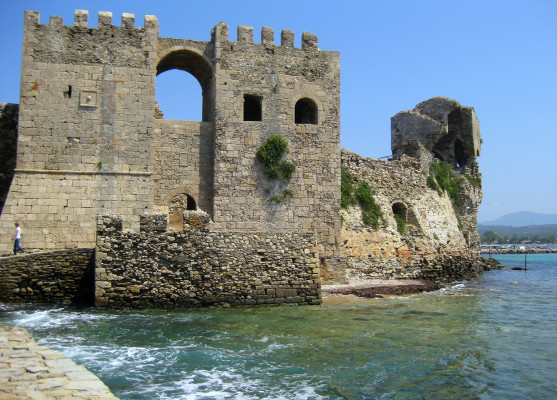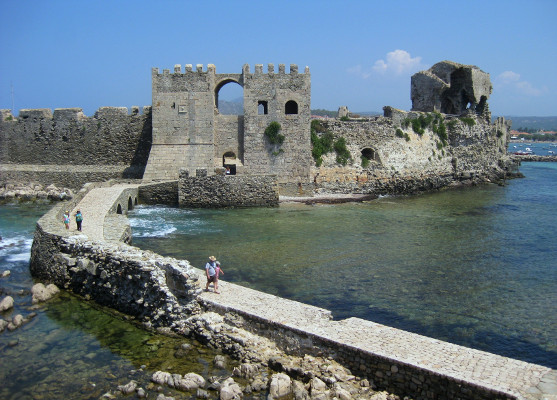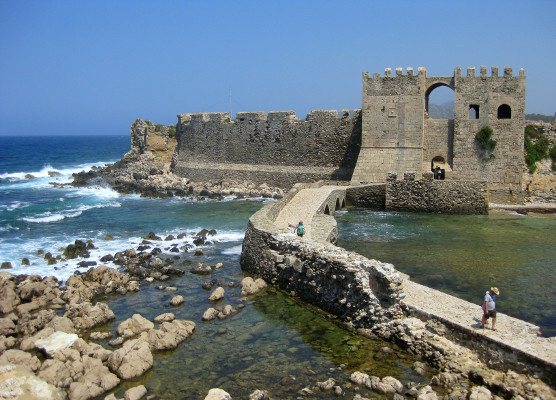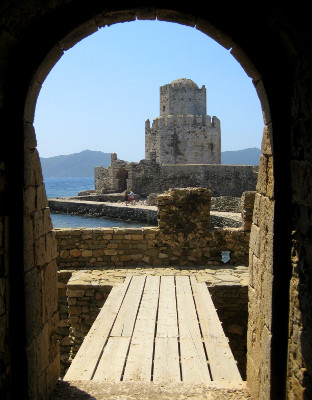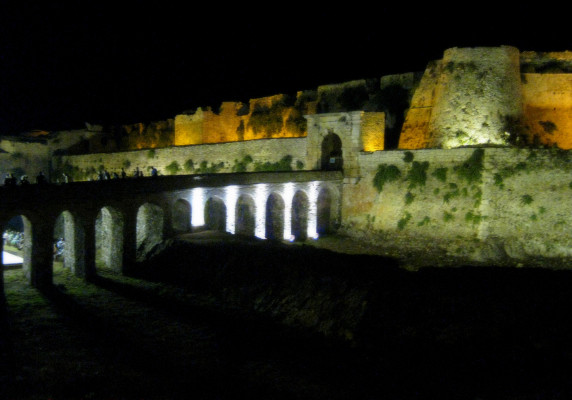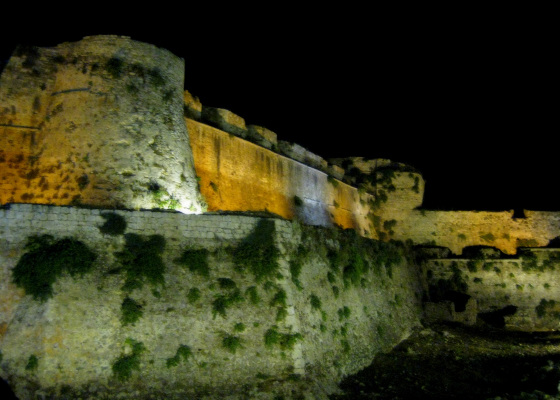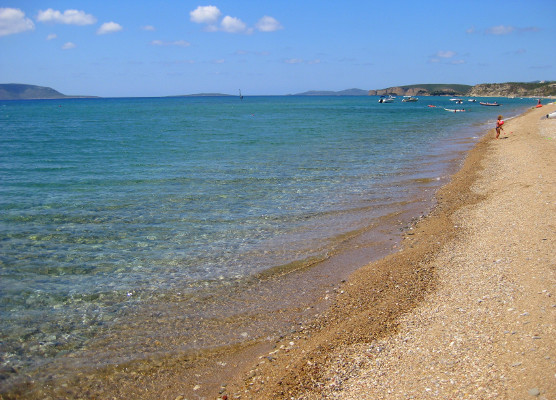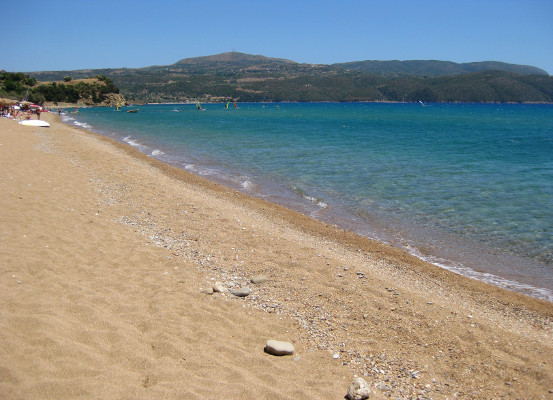The Castle of Methoni, one of the most important castles in Greece, is surrounded by sea. It was built by the Venetians, when they became masters of the city, in 1209 AD. It is built on a cliff that penetrates the sea and is separated from the land by an artificial trench. It has an area of 93 acres.
( https://en.wikipedia.org/wiki/Methoni_Castle )
On the northern side is the portal, made of rectangular tufa bricks.
The entrance gate ends in an arch framed on the right and left by pilasters with Corinthian capitals. On the right and left of the entrance two large battlements can be seen. On the south part of the walls rises the spectacular sea gate which has recently been restored. A stone-paved stretch leads over a small bridge to the small fortified islet of Bourtzi. The east side of the walls also reached initially to the sea. Nowadays, a long strand of beach lies in front of a large part of it. Parallel to the east wall, up to the Bourtzi, there was a pier and this is where the small fortified harbor was formed (mandrachio), while the big one was to the northeast where ships could be pulled. The walls, the towers, the bastions, the northwest artillery platform and the castle's various gates have been dated thanks to the identification of Venetian coats of arms, still standing.
Close to the entrance of the castle, there is a Venetian well. This well, along with another one, near the bridge at the entrance of Methoni, have been designated as historic monuments. The Church of Aghios Nikolaos has also been characterized as a monument as a remarkable example of ecclesiastical architecture in the years after 1830.
(Click pictures to enlarge)
The town of Methoni is a traditional settlement of Venetian-styled houses and cobbled streets. In Methoni one can find one of the first schools built by the Governor Ioannis Kapodistrias in the newly-found Hellenic State (on March of 1830), which is a “mutual-teaching school”.
According to the “mutual-teaching method”, the only teacher of a “mutual-teaching school” was teaching at once all the students, with the help of the «πρωτόσχολοι» (“protoscholi” translated as “first of the school”). The “protoscholi” were the best students, chosen by the teacher, with the help of the class’ or school’s students, and they had to be distinguished for their ability to manage their classmates, their performance in classes and their behavior as well. The “protoscholi”, instead of textbooks, they had boards, with texts from various classes, hung on the walls. They undertook the dictation of the courses and even the analysis and interpretation of the new cognitive modules. The teacher, who had the role of the general regulator of the school life, was limited to briefing the “protoscholi” for the lessons they had to teach, supervising and examining the students, teaching only a little in exceptional cases. During the teaching, there was silence, not only on the part of the students but also on the part of the teacher. «Ας μη στοχάζεται ο διδάσκαλος ότι πρέπει να λαλή πολύ ή να φωνάζη μεγαλοφώνως, διά να σιγήσωσιν οι μαθηταί του ... πρέπει οι λόγοι του διδασκάλου να ήναι σπάνιοι. τότε λαλών, ακούεται ...Διά της επιμόνου διατηρήσεως της σιωπής θέλει έχει τις και σχολείον εύτακτον.Περιπλέον αύτη είναι ο ουσιώδης κανών εις εν σχολείον ...». (translation: "Let the teacher not think that he must speak a great deal or shout aloud, in order to silence his disciples ... the speeches of the teacher must be scarce. then he is heard... Through the persistence of the silence, he will have the school in order. First and foremost, that (the persistence of the silence) is the fundamental principle in a school ... ").
The teacher of the “mutual-teaching school” had to be “active, endowed with a stability of character, loving the order, devoted to his profession, which he must embrace with great love towards it. He has to be happy to be in the midst of the children, and to accept whatever they may do, even the smallest things, with understanding. If he does not have these assets, let him do another job. He will not be able to be any good in teaching.” (original text: «δραστικόν, προικισμένον με χαρακτήρος ευστάθειαν, αγαπώντα την ευταξίαν, αφοσιωμένον εις το επάγγελμά του, το οποίον πρέπει να εναγκαλισθή κατά τινα ιδίαν κλίσιν προς αυτό. Πρέπει να ευχαριστήται να ήναι αναμέσον των παιδίων, και να καταδέχεται να συγκαταβαίνη χάριν αυτών και εις τα παραμικρά πράγματα. Αν δεν έχη τα προτερήματα ταύτα, ας έμβη εις κανέν άλλο στάδιο. εις το διδασκαλικόν δεν θέλει κάμει κανένα όφελος»).
In the first years of the Hellenic State, the Government showed great interest in writing and translating basic textbooks for the “mutual-teaching schools”.
(Click pictures to enlarge)

